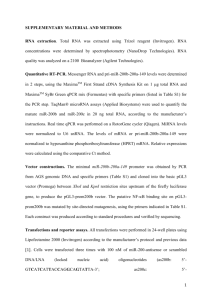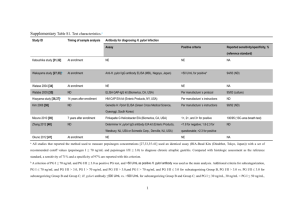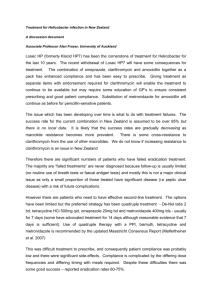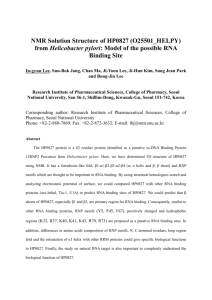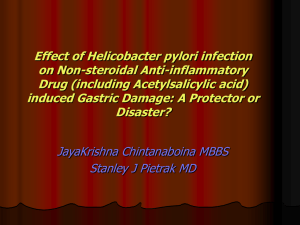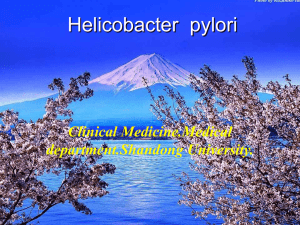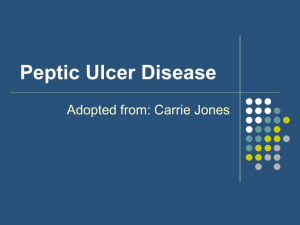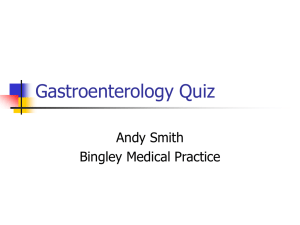EMJ_review_SMSMITH - TARA
advertisement
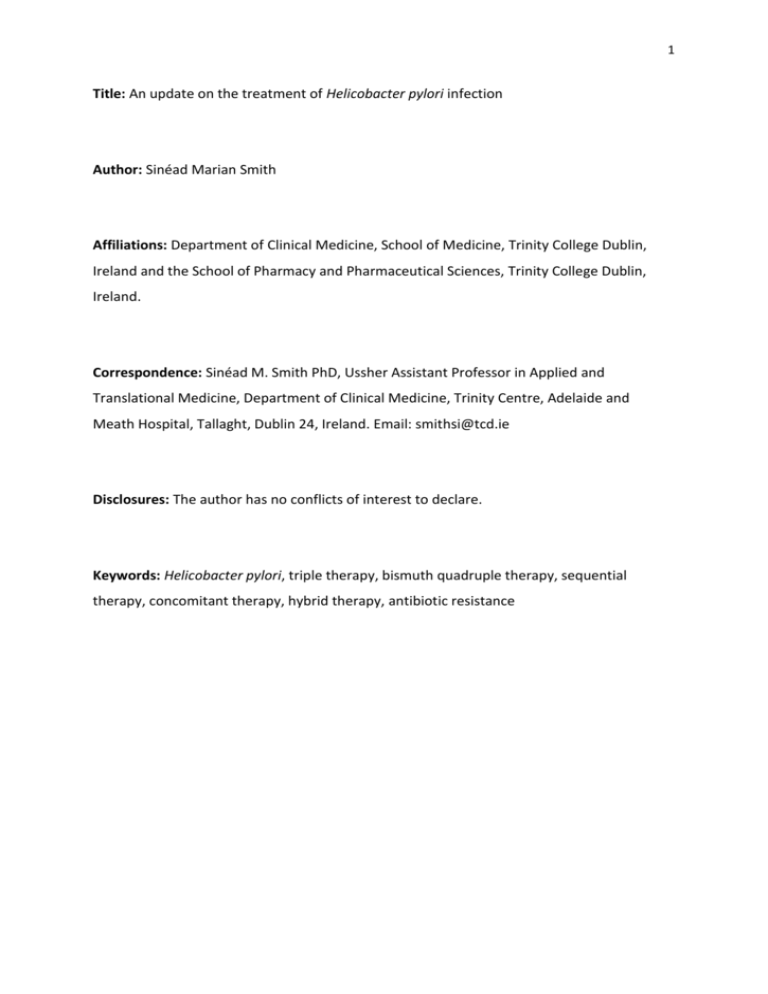
1 Title: An update on the treatment of Helicobacter pylori infection Author: Sinéad Marian Smith Affiliations: Department of Clinical Medicine, School of Medicine, Trinity College Dublin, Ireland and the School of Pharmacy and Pharmaceutical Sciences, Trinity College Dublin, Ireland. Correspondence: Sinéad M. Smith PhD, Ussher Assistant Professor in Applied and Translational Medicine, Department of Clinical Medicine, Trinity Centre, Adelaide and Meath Hospital, Tallaght, Dublin 24, Ireland. Email: smithsi@tcd.ie Disclosures: The author has no conflicts of interest to declare. Keywords: Helicobacter pylori, triple therapy, bismuth quadruple therapy, sequential therapy, concomitant therapy, hybrid therapy, antibiotic resistance 2 Abstract: H. pylori treatment is becoming a challenge in light of increasing antimicrobial resistance and falling eradication rates. This is a cause for concern based on the complications of H. pylori infection, which include gastric and peptic ulcers, gastric cancer and mucosaassociated lymphoid tissue lymphoma. This review discusses recent data assessing the current treatment options for H. pylori infection and the importance of considering the prevalence of antibiotic resistance at a regional level when choosing an appropriate therapy. Alternatives to the standard first-line treatment, such as bismuth and non-bismuth quadruple therapies are outlined, and rescue therapies involving levofloxacin- and rifabutin are also reviewed. 3 Introduction H. pylori is a gram-negative bacterium that specifically colonises the stomachs of approximately 50% of the global population. Infection is usually acquired in early childhood and despite triggering a vigorous immune response, H. pylori persists for life if left untreated. Prevalence of H. pylori infection varies throughout the world and is associated with older age and with lower socioeconomic conditions [1]. Although most infected individuals do not develop any significant symptoms, H. pylori is causally linked to a number of gastrointestinal disorders; peptic ulcers have been reported to develop in 1 to 10% of those infected, while gastric cancer and gastric mucosa-associated lymphoid tissue lymphoma present in 0.1 to 3% and <0.01% of infected individuals, respectively . The World Health Organization’s International Agency for Research on Cancer has classified H. pylori as a definite (group 1) carcinogen [2]. H. pylori has also been linked to unexplained irondeficiency anaemia and idiopathic thrombocytopenic purpura, with recent guidelines on the management of these conditions recommending H. pylori eradication where present [3, 4]. Consensus guidelines on the management of H. pylori infection recommend a standard firstline triple therapy that consists of a proton pump inhibitor (PPI) together with the antibiotics clarithromycin and amoxicillin taken twice daily for 7-14 days [5-7] (Table 1). Metronidazole is used instead of amoxicillin in penicillin-allergic individuals. Unfortunately the success rate of first-line triple therapy has fallen in many countries. A number of factors contribute to treatment failure, including high bacterial load, low gastric pH and impaired mucosal immunity [8], although the main reasons for H. pylori treatment failure are thought to be poor compliance and antimicrobial resistance [5, 8-10]. Several strategies have been shown to improve the efficacy of standard triple therapy. A recently published metaanalysis has shown that increasing the duration of triple therapy from either 7 to 10 days or 10 to 14 days results in a significantly higher eradication rate [11]. Fourteen days was found to provide the most effective eradication rate using triple therapy involving a PPI, amoxicillin and clarithromycin [11]. Increasing the dose of PPIs also has a positive effect on treatment outcome [12]. If initial therapy fails however, a levofloxacin-based rescue therapy is recommended [5, 10]. If subsequent treatment is required, rifabutin-based regimens may 4 be prescribed [5, 13], but treatment should be guided by antimicrobial susceptibility testing [5]. H. pylori antibiotic resistance H. pylori antibiotic resistance is thought to develop due to the outgrowth of small existing populations of resistant organisms and is associated with prior antibiotic use. Analysis of cumulative and yearly outpatient antibiotic consumption in Europe revealed a significant association between the use of long-acting macrolides and resistance of H. pylori to clarithromycin, and between previous quinolone use and levofloxacin resistance [14]. Studies on the prevalence of antibiotic resistance in the UK and USA have also shown previous antibiotic use increases the risk of harbouring resistant strains of H. pylori [15, 16]. The genetic mutations mediating resistance to clarithromycin and fluoroquinolones have been well characterised [17]. Clarithromycin inhibits protein synthesis by targeting the bacterial ribosomal subunit. Single point mutations within the H. pylori rrl gene encoding the 23S ribosomal RNA component confer clarithromycin resistance [18]. The most significant mutations conferring quinolone resistance are located in the H. pylori gyrA gene, which encodes the A subunit of the DNA gyrase enzyme involved in DNA strain relief during bacterial replication [19]. In terms of metronidazole resistance, a definitive panel of resistance-associated point mutations has not yet been characterised, although mutations in the rdxA and frxA genes have been implicated [18]. Although mutations in the DNA encoding the 16S rRNA involved in tetracycline resistance, the rpoB gene involved in rifabutin resistance and the pbp-1a gene involved in amoxicillin resistance have also been described [18, 20-22], they are of less interest since the rates of H. pylori resistance to these antibiotics are low in most regions [14, 15, 21]. The most recent assessment of primary antibiotic resistance in Europe reported overall resistance rates for clarithromycin, levofloxacin and metronidazole of 17.5%, 14.1%, and 34.9% respectively, with a prevalence ≤1% for tetracycline, rifampicin and amoxicillin [14]. Almost 8% of strains isolated had combined resistance to metronidazole and clarithromycin. 5 The rate of clarithromycin resistance had almost doubled since the previous European survey [23], which is a cause for concern as clarithromycin resistance decreases the efficacy of standard first-line triple therapy by up to 70% [5]. Metronidazole resistance was high at 34.9% [14], but the level had not changed significantly since the previous Europe-wide study [23]. The impact of metronidazole resistance on H. pylori eradication is less than that of clarithromycin resistance, and can be overcome by increasing the dose and duration of treatment or by prescription of bismuth-containing quadruple therapy [24]. Interestingly, variations in the prevalence of antibiotic resistance across European countries was observed (recent data summarized in Table 2). The resistance rate for clarithromycin was <10% in Northern European countries, while most countries in the rest of Europe (except Spain and Germany) had a resistance rate of >15% [14]. Such variations in antibiotic resistance have also been reported on a local level within countries. For example, a recent study within the UK indicated that the resistance rates to clarithromycin, metronidazole and quinolones were 18%, 43%, 13% respectively in Wales but 3%, 22%, 1% respectively in England [15]. Differences in resistance rates have also been reported outside Europe (Table 2). For example, although the overall resistance rates for clarithromycin, metronidazole and levofloxacin in Thailand were 3.7%, 36% and 7.2% respectively, metronidazole resistance was more prevalent in Southern Thailand than North Eastern Thailand (66.7% versus 33.3%) [21]. Such diversity in the prevalence of antibiotic resistance has important consequences when it comes to choosing the appropriate therapy for successfully eradicating H. pylori in a given population. According to the Maastricht IV guidelines, standard triple therapy should now only be prescribed in regions where the prevalence of clarithromycin resistance is known to be less than 15-20% [5]. While no new drug has been developed as a direct replacement, recent trials have assessed the efficacies of therapies involving different combinations of known antibiotics, the results of which are discussed below. 6 Bismuth quadruple therapy Bismuth quadruple therapy (Table 1) has been recommended as a first-line therapy in regions of high clarithromycin resistance or in low clarithromycin resistance areas as an alternative to standard triple therapy or as a rescue regimen [5]. A recent meta-analysis reported eradication rates of 77.6% and 68.9% for bismuth quadruple therapy and standard triple therapy, respectively [25]. Compliance and adverse events were similar across the two treatment groups and bismuth quadruple therapy did not appear to be affected by metronidazole resistance. Variations in the bismuth therapy treatment regimens were described in terms of antibiotic dose and treatment duration. A sub-analysis of the data showed that although bismuth therapy for 10 days was more effective than 7 days of triple therapy, the two therapies given for the same length of time yielded similar eradication rates [25]. In keeping with the idea that the duration of bismuth quadruple therapy affects eradication success, a 95% eradication rate for a 14-day bismuth therapy regimen has been described [26]. In terms of rescue therapy, a meta-analysis by Marin et al. (2013) indicated that when bismuth-containing quadruple therapy was prescribed following failure of standard clarithromycin-based triple therapy, the eradication rates were 76%, 77% and 82% for 7, 10 and 14 days respectively [10]. Additionally, high H. pylori eradication rates with bismuth therapy have been described in patients who did not respond to previous therapies, including those with metronidazole resistance [27-29]. Taken together, these findings support a role for bismuth quadruple therapies as both first-line and rescue regimens. However, due the unavailability of tetracycline and bismuth salts in several countries, bismuth quadruple therapy may not always represent an accessible treatment option [10, 30]. 7 Non-bismuth quadruple therapy Sequential therapy Non-bismuth quadruple therapy has been proposed as an alternative to bismuth quadruple therapy for first-line treatment in regions with high clarithromycin resistance [5]. The efficacy of sequential therapy (Table 1) compared to triple therapy, however, depends on the treatment durations under comparison and the study population. A systematic review and meta-analysis performed by Gatta et al. (2013), comparing 46 randomized control trials, indicated that sequential therapy was superior to 7 day triple therapy, marginally superior to 10 day triple therapy, but not superior to 14 day triple therapy [31]. Geographic variations in the prevalence of antibiotic resistance appear to be a key factor affecting the lack of difference between sequential therapy and 14 day triple therapy, as a meta-analysis by Losurdo et al. (2015) reported that sequential therapy was superior to 14 days triple therapy in areas with high clarithromycin resistance but sequential and triple therapy were similar in areas of high metronidazole resistance [32]. Of note, the Gatta study described an overall eradication rate for sequential therapy of just 37% in patients infected with H. pylori strains resistant to both clarithromycin and metronidazole resistance [31], indicating that dual antibiotic resistance significantly impacts the efficacy of sequential therapy. Concomitant therapy Standard triple therapy can be converted to concomitant therapy (Table 1) by the addition of 500 mg of metronidazole or tinidazole twice daily. A meta-analysis of the randomized control trials comparing concomitant with standard triple therapy revealed eradication rates of 90% and 78% for concomitant and triple therapy respectively by intention-to-treat analysis [33]. The analysis indicated that clarithromycin resistance may impact the efficacy of concomitant therapy, but to a lesser extent than standard triple therapy [33]. A recent multi-centre trial in Spain comparing 14 day triple therapy with 14 day concomitant therapy revealed that the extended concomitant therapy achieved significantly higher cure rates (>90%) compared to 14 day triple therapy with milder adverse events and no effect on compliance [12]. Evidence to date suggests similar eradication rates when concomitant 8 therapy is compared to sequential therapy with no significant differences in terms of compliance or adverse events [30, 31, 34, 35]. Thus, while the eradication rates for concomitant and sequential therapy appear similar, both appear superior to standard triple therapy as a first-line treatment option. Hybrid therapy The recently described hybrid therapy represents a combined version of sequential and concomitant therapy, comprising a PPI with amoxicillin for 14 days plus clarithromycin and a nitroimidazole derivative for the final 7 days (Table 1). Hsu et al. (2011) initially reported eradication rates of >90% for hybrid therapy [36]. However, it is unclear whether hybrid therapy has any significant advantage over sequential or concomitant therapy as recent meta-analyses of trials to date demonstrated similar eradication rates across all 3 therapies [37, 38]. Further studies in additional countries are required to determine whether hybrid therapy exhibits improved efficacy over sequential or concomitant therapy as a first-line therapy. Second-line and subsequent H. pylori eradication therapies Following failure of standard triple therapy, a levofloxacin-based rescue therapy (Table 1) is recommended unless local data indicates high rates of quinolone resistance [5, 10]. Metaanalyses have shown that 10 days of levofloxacin triple therapy is superior to bismuth quadruple therapy, but not 7 days of levofloxacin therapy [39, 40]. Including levofloxacin in sequential therapy has also been shown to be effective for patients who have failed either sequential or triple therapy [41]. Indeed, an analysis of 3 studies comparing sequential therapy with sequential therapy containing levofloxacin (instead of clarithromycin) demonstrated increased eradication success using the modified sequential therapy [31]. Combining levofloxacin and bismuth in patients who have previously failed H. pylori treatment has also been demonstrated as a successful strategy for H. pylori eradication [42]. As levofloxacin resistance is emerging in many countries [14], rifabutin-based triple therapy has been suggested as an alternative rescue therapy. Primary H. pylori rifabutin resistance 9 is low [43] and rifabutin is effective in patients with dual metronidazole and clarithromycin resistance [13]. As a fourth line therapy, Gisbert et al., (2012) provide a rationale for the use of rifabutin-based therapy as a valid rescue strategy following multiple eradication failures [44]. Tailoring therapy based on antibiotic resistance data Given that antibiotic resistance impacts treatment outcome and rates of resistance vary between different regions, surveillance of antibiotic resistance represents a key strategy in choosing the appropriate first-line H. pylori treatment regimen in a given population. Culture of H. pylori from gastric biopsy specimens and antimicrobial susceptibility testing by means of minimum inhibitory concentration determination has been considered the gold standard for assessing H. pylori antibiotic resistance to date. However, H. pylori is a fastidious bacterium and culture is time-consuming and often challenging with low sensitivity values [17]. Molecular testing for H. pylori antibiotic resistance offers an attractive alternative to culture and allows for analysis of H. pylori DNA directly from biopsy samples, providing a key opportunity same-day diagnosis. In addition, molecular tests have been used to analyse stool samples [45, 46], potentially enabling H. pylori antimicrobial susceptibility testing through non-invasive procedures. In addition to surveillance, evidence from numerous studies provides a rationale for tailoring treatment based on antimicrobial susceptibility testing to improve increase the efficacy of both first-line [47-49] and rescue therapies [50, 51]. Cost-effectiveness of tailored therapy is a genuine consideration, but it is thought to be economically viable especially in areas of high clarithromycin resistance [47, 48]. Summary H. pylori antibiotic resistance exhibits regional variations and is constantly evolving. As such, local resistance data is imperative in guiding efficacious treatment choices. In regions where high clarithromycin resistance has been detected, evidence supports the use of both bismuth and non-bismuth quadruple therapies as first-line alternatives to standard triple 10 therapy. Levofloxacin-based rescue therapies are useful in areas of low quinolone resistance; while rifabutin offers a promising alternative if levofloxacin resistance is detected or following multiple treatment failures. Treatment duration is a key factor in H. pylori eradication success, with studies demonstrating that increasing the treatment duration improves the efficacy of all of the therapies discussed above. However, longer treatment durations may affect compliance, therefore adherence should be strongly emphasised for first and any subsequent H. pylori eradication therapies. 11 References [1] Smith SM, Haider RB, O'Connor H, McNamara D, O'Morain C. Practical treatment of Helicobacter pylori: a balanced view in changing times. Eur J Gastroenterol Hepatol. 2014; 26: 819-825. [2] Infection with Helicobacter pylori. IARC Working Group on the Evaluation of Carcinogenic Risks to Humans. IARC monographs on the evaluation of carcinogenic risks to humans., 1994; 177-240. [3] Goddard AF, James MW, McIntyre AS, Scott BB, British Society of G. Guidelines for the management of iron deficiency anaemia. Gut. 2011; 60: 1309-1316. [4] Neunert C, Lim W, Crowther M, Cohen A, Solberg L, Jr., Crowther MA, et al. The American Society of Hematology 2011 evidence-based practice guideline for immune thrombocytopenia. Blood. 2011; 117: 4190-4207. [5] Malfertheiner P, Megraud F, O'Morain CA, Atherton J, Axon AT, Bazzoli F, et al. Management of Helicobacter pylori infection--the Maastricht IV/ Florence Consensus Report. Gut. 2012; 61: 646-664. [6] Fock KM, Katelaris P, Sugano K, Ang TL, Hunt R, Talley NJ, et al. Second Asia-Pacific Consensus Guidelines for Helicobacter pylori infection. J Gastroenterol Hepatol. 2009; 24: 1587-1600. [7] Chey WD, Wong BC, Practice Parameters Committee of the American College of G. American College of Gastroenterology guideline on the management of Helicobacter pylori infection. Am J Gastroenterol. 2007; 102: 1808-1825. [8] Graham DY, Fischbach L. Helicobacter pylori treatment in the era of increasing antibiotic resistance. Gut. 2010; 59: 1143-1153. [9] O'Connor JP, Taneike I, O'Morain C. Improving compliance with Helicobacter pylori eradication therapy: when and how? Therap Adv Gastroenterol. 2009; 2: 273-279. [10] Marin AC, McNicholl AG, Gisbert JP. A review of rescue regimens after clarithromycin-containing triple therapy failure (for Helicobacter pylori eradication). Expert Opin Pharmacother. 2013; 14: 843-861. [11] Yuan Y, Ford AC, Khan KJ, Gisbert JP, Forman D, Leontiadis GI, et al. Optimum duration of regimens for Helicobacter pylori eradication. Cochrane Database Syst Rev. 2013; 12: CD008337. 12 [12] Molina-Infante J, Lucendo AJ, Angueira T, Rodriguez-Tellez M, Perez-Aisa A, Balboa A, et al. Optimised empiric triple and concomitant therapy for Helicobacter pylori eradication in clinical practice: the OPTRICON study. Aliment Pharmacol Ther. 2015; 41: 581-589. [13] Toracchio S, Capodicasa S, Soraja DB, Cellini L, Marzio L. Rifabutin based triple therapy for eradication of H. pylori primary and secondary resistant to tinidazole and clarithromycin. Dig Liver Dis. 2005; 37: 33-38. [14] Megraud F, Coenen S, Versporten A, Kist M, Lopez-Brea M, Hirschl AM, et al. Helicobacter pylori resistance to antibiotics in Europe and its relationship to antibiotic consumption. Gut. 2013; 62: 34-42. [15] McNulty CA, Lasseter G, Shaw I, Nichols T, D'Arcy S, Lawson AJ, et al. Is Helicobacter pylori antibiotic resistance surveillance needed and how can it be delivered? Aliment Pharmacol Ther. 2012; 35: 1221-1230. [16] Shiota S, Reddy R, Alsarraj A, El-Serag HB, Graham DY. Antibiotic Resistance of Helicobacter pylori Among Male United States Veterans. Clin Gastroenterol Hepatol. 2015. [17] Smith SM, O'Morain C, McNamara D. Antimicrobial susceptibility testing for Helicobacter pylori in times of increasing antibiotic resistance. World J Gastroenterol. 2014; 20: 9912-9921. [18] Ierardi E, Giorgio F, Losurdo G, Di Leo A, Principi M. How antibiotic resistances could change Helicobacter pylori treatment: A matter of geography? World J Gastroenterol. 2013; 19: 8168-8180. [19] Wang LH, Cheng H, Hu FL, Li J. Distribution of gyrA mutations in fluoroquinolone- resistant Helicobacter pylori strains. World J Gastroenterol. 2010; 16: 2272-2277. [20] Glocker E, Berning M, Gerrits MM, Kusters JG, Kist M. Real-time PCR screening for 16S rRNA mutations associated with resistance to tetracycline in Helicobacter pylori. Antimicrob Agents Chemother. 2005; 49: 3166-3170. [21] Vilaichone RK, Gumnarai P, Ratanachu-Ek T, Mahachai V. Nationwide survey of Helicobacter pylori antibiotic resistance in Thailand. Diagn Microbiol Infect Dis. 2013. [22] Megraud F, Lehours P. Helicobacter pylori detection and antimicrobial susceptibility testing. Clin Microbiol Rev. 2007; 20: 280-322. [23] Glupczynski Y, Megraud F, Lopez-Brea M, Andersen LP. European multicentre survey of in vitro antimicrobial resistance in Helicobacter pylori. Eur J Clin Microbiol Infect Dis. 2001; 20: 820-823. 13 [24] Malfertheiner P, Bazzoli F, Delchier JC, Celinski K, Giguere M, Riviere M, et al. Helicobacter pylori eradication with a capsule containing bismuth subcitrate potassium, metronidazole, and tetracycline given with omeprazole versus clarithromycin-based triple therapy: a randomised, open-label, non-inferiority, phase 3 trial. Lancet. 2011; 377: 905913. [25] Venerito M, Krieger T, Ecker T, Leandro G, Malfertheiner P. Meta-analysis of bismuth quadruple therapy versus clarithromycin triple therapy for empiric primary treatment of Helicobacter pylori infection. Digestion. 2013; 88: 33-45. [26] Salazar CO, Cardenas VM, Reddy RK, Dominguez DC, Snyder LK, Graham DY. Greater than 95% success with 14-day bismuth quadruple anti- Helicobacter pylori therapy: a pilot study in US Hispanics. Helicobacter. 2012; 17: 382-390. [27] Liang X, Xu X, Zheng Q, Zhang W, Sun Q, Liu W, et al. Efficacy of bismuth-containing quadruple therapies for clarithromycin-, metronidazole-, and fluoroquinolone-resistant Helicobacter pylori infections in a prospective study. Clin Gastroenterol Hepatol. 2013; 11: 802-807 e801. [28] Delchier JC, Malfertheiner P, Thieroff-Ekerdt R. Use of a combination formulation of bismuth, metronidazole and tetracycline with omeprazole as a rescue therapy for eradication of Helicobacter pylori. Aliment Pharmacol Ther. 2014; 40: 171-177. [29] Gisbert JP, Perez-Aisa A, Rodrigo L, Molina-Infante J, Modolell I, Bermejo F, et al. Third-line rescue therapy with bismuth-containing quadruple regimen after failure of two treatments (with clarithromycin and levofloxacin) for H. pylori infection. Dig Dis Sci. 2014; 59: 383-389. [30] McNicholl AG, Marin AC, Molina-Infante J, Castro M, Barrio J, Ducons J, et al. Randomised clinical trial comparing sequential and concomitant therapies for Helicobacter pylori eradication in routine clinical practice. Gut. 2014; 63: 244-249. [31] Gatta L, Vakil N, Vaira D, Scarpignato C. Global eradication rates for Helicobacter pylori infection: systematic review and meta-analysis of sequential therapy. BMJ. 2013; 347: f4587. [32] Losurdo G, Leandro G, Principi M, Giorgio F, Montenegro L, Sorrentino C, et al. Sequential vs. prolonged 14-day triple therapy for Helicobacter pylori eradication: the metaanalysis may be influenced by 'geographical weighting'. Int J Clin Pract. 2015. 14 [33] Gisbert JP, Calvet X. Update on non-bismuth quadruple (concomitant) therapy for eradication of Helicobacter pylori. Clin Exp Gastroenterol. 2012; 5: 23-34. [34] Wu DC, Hsu PI, Wu JY, Opekun AR, Kuo CH, Wu IC, et al. Sequential and concomitant therapy with four drugs is equally effective for eradication of H pylori infection. Clin Gastroenterol Hepatol. 2010; 8: 36-41 e31. [35] Huang YK, Wu MC, Wang SS, Kuo CH, Lee YC, Chang LL, et al. Lansoprazole-based sequential and concomitant therapy for the first-line Helicobacter pylori eradication. J Dig Dis. 2012; 13: 232-238. [36] Hsu PI, Wu DC, Wu JY, Graham DY. Modified sequential Helicobacter pylori therapy: proton pump inhibitor and amoxicillin for 14 days with clarithromycin and metronidazole added as a quadruple (hybrid) therapy for the final 7 days. Helicobacter. 2011; 16: 139-145. [37] He L, Deng T, Luo H. Meta-analysis of sequential, concomitant and hybrid therapy for Helicobacter pylori eradication. Intern Med. 2015; 54: 703-710. [38] Wang B, Wang YH, Lv ZF, Xiong HF, Wang H, Yang Y, et al. Review: efficacy and safety of hybrid therapy for Helicobacter pylori infection: a systematic review and meta-analysis. Helicobacter. 2015; 20: 79-88. [39] Li Y, Huang X, Yao L, Shi R, Zhang G. Advantages of Moxifloxacin and Levofloxacin- based triple therapy for second-line treatments of persistent Helicobacter pylori infection: a meta analysis. Wien Klin Wochenschr. 2010; 122: 413-422. [40] Di Caro S, Fini L, Daoud Y, Grizzi F, Gasbarrini A, De Lorenzo A, et al. Levofloxacin/amoxicillin-based schemes vs quadruple therapy for Helicobacter pylori eradication in second-line. World J Gastroenterol. 2012; 18: 5669-5678. [41] Liou JM, Chen CC, Chen MJ, Chen CC, Chang CY, Fang YJ, et al. Sequential versus triple therapy for the first-line treatment of Helicobacter pylori: a multicentre, open-label, randomised trial. Lancet. 2013; 381: 205-213. [42] Gisbert JP, Romano M, Gravina AG, Solis-Munoz P, Bermejo F, Molina-Infante J, et al. Helicobacter pylori second-line rescue therapy with levofloxacin- and bismuth-containing quadruple therapy, after failure of standard triple or non-bismuth quadruple treatments. Aliment Pharmacol Ther. 2015; 41: 768-775. [43] Gisbert JP, Calvet X. Review article: rifabutin in the treatment of refractory Helicobacter pylori infection. Aliment Pharmacol Ther. 2012; 35: 209-221. 15 [44] Gisbert JP, Castro-Fernandez M, Perez-Aisa A, Cosme A, Molina-Infante J, Rodrigo L, et al. Fourth-line rescue therapy with rifabutin in patients with three Helicobacter pylori eradication failures. Aliment Pharmacol Ther. 2012; 35: 941-947. [45] Vecsei A, Innerhofer A, Binder C, Gizci H, Hammer K, Bruckdorfer A, et al. Stool polymerase chain reaction for Helicobacter pylori detection and clarithromycin susceptibility testing in children. Clin Gastroenterol Hepatol. 2010; 8: 309-312. [46] Scaletsky IC, Aranda KR, Garcia GT, Goncalves ME, Cardoso SR, Iriya K, et al. Application of real-time PCR stool assay for Helicobacter pylori detection and clarithromycin susceptibility testing in Brazilian children. Helicobacter. 2011; 16: 311-315. [47] Romano M, Marmo R, Cuomo A, De Simone T, Mucherino C, Iovene MR, et al. Pretreatment antimicrobial susceptibility testing is cost saving in the eradication of Helicobacter pylori. Clin Gastroenterol Hepatol. 2003; 1: 273-278. [48] Cosme A, Montes M, Martos M, Gil I, Mendarte U, Salicio Y, et al. Usefulness of antimicrobial susceptibility in the eradication of Helicobacter pylori. Clin Microbiol Infect. 2013; 19: 379-383. [49] Lopez-Gongora S, Puig I, Calvet X, Villoria A, Baylina M, Munoz N, et al. Systematic review and meta-analysis: susceptibility-guided versus empirical antibiotic treatment for Helicobacter pylori infection. J Antimicrob Chemother. 2015. [50] Fiorini G, Vakil N, Zullo A, Saracino IM, Castelli V, Ricci C, et al. Culture-based selection therapy for patients who did not respond to previous treatment for Helicobacter pylori infection. Clin Gastroenterol Hepatol. 2013; 11: 507-510. [51] Liou JM, Chen CC, Chang CY, Chen MJ, Fang YJ, Lee JY, et al. Efficacy of genotypic resistance-guided sequential therapy in the third-line treatment of refractory Helicobacter pylori infection: a multicentre clinical trial. J Antimicrob Chemother. 2013; 68: 450-456. [52] Gao W, Cheng H, Hu F, Li J, Wang L, Yang G, et al. The evolution of Helicobacter pylori antibiotics resistance over 10 years in Beijing, China. Helicobacter. 2010; 15: 460-466. [53] Su P, Li Y, Li H, Zhang J, Lin L, Wang Q, et al. Antibiotic resistance of Helicobacter pylori isolated in the Southeast Coastal Region of China. Helicobacter. 2013; 18: 274-279. [54] Yamade M, Sugimoto M, Uotani T, Nishino M, Kodaira C, Furuta T. Resistance of Helicobacter pylori to quinolones and clarithromycin assessed by genetic testing in Japan. J Gastroenterol Hepatol. 2011; 26: 1457-1461. 16 [55] Camargo MC, Garcia A, Riquelme A, Otero W, Camargo CA, Hernandez-Garcia T, et al. The problem of Helicobacter pylori resistance to antibiotics: a systematic review in Latin America. Am J Gastroenterol. 2014; 109: 485-495. [56] Seck A, Burucoa C, Dia D, Mbengue M, Onambele M, Raymond J, et al. Primary antibiotic resistance and associated mechanisms in Helicobacter pylori isolates from Senegalese patients. Ann Clin Microbiol Antimicrob. 2013; 12: 3. 17 Table 1: H. pylori treatment regimens. Therapy Description Standard triple therapy PPI, clarithromycin & amoxicillin (7-14 days) Bismuth quadruple therapy PPI, bismuth salt, metronidazole & tetracycline (7-14 days) Sequential therapy PPI & amoxicillin (5-7 days) followed by PPI, clarithromycin & metronidazole (5-7 days) Concomitant therapy PPI, amoxicillin, clarithromycin & metronidazole/tinidazole (7-14 days) Hybrid therapy PPI, amoxicillin (14 days) with clarithromycin and tinidazole (for the final 7 days) Levofloxacin-based triple PPI, levofloxacin, amoxicillin (7-14 days) therapy Levofloxacin-based sequential PPI & amoxicillin (5 days) followed by PPI, levofloxacin therapy & metronidazole (5 days) Rifabutin-based triple therapy PPI, amoxicillin & rifabutin (7-14 days) 18 Table 2: Recent data on the prevalence of antibiotic Region Resistance Rates Reference Clar Met Lev 37.2%2 63.9%2 50.3%2 [52] East 21.5%2 95.4%2 20.6%2 [53] northern 7.7%1 28.6%1 7.7%1 [14] southern 21.5%1 29.7%1 13.1%1 [14] Europe; western and 18.7%1 43.8%1 18.6%1 [14] 38.8%1 ND 34%1 [54] 55.6%2 ND 38.6%2 Latin America 12%1 53%1 15%1 [55] Senegal 1%1 85%1 15%1 [56] Thailand 3.7%1 36%1 7.2%1 [21] USA 16.4%2 20.3%2 31.3%2 [16] China; Beijing China; South coastal region Europe; countries Europe; countries central countries Japan Clar: clarithromycin, Met: metronidazole, Lev: levofloxacin. 2Overall resistance rate. 1Primary resistance rate;
